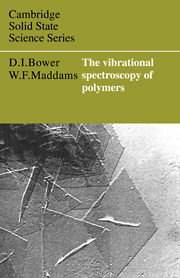Book contents
- Frontmatter
- Contents
- Preface
- 1 Introduction
- 2 Symmetry and normal modes of vibration
- 3 The vibrational modes of polymers
- 4 Infrared and Raman spectra
- 5 The characterization of polymers
- 6 The microstructure of polymers
- References for chapters 5 and 6
- A note on the use of the indexes
- Index of spectra illustrated
- Index of point groups
- Index of group modes
- Index of polymers
- Main index
6 - The microstructure of polymers
Published online by Cambridge University Press: 05 May 2010
- Frontmatter
- Contents
- Preface
- 1 Introduction
- 2 Symmetry and normal modes of vibration
- 3 The vibrational modes of polymers
- 4 Infrared and Raman spectra
- 5 The characterization of polymers
- 6 The microstructure of polymers
- References for chapters 5 and 6
- A note on the use of the indexes
- Index of spectra illustrated
- Index of point groups
- Index of group modes
- Index of polymers
- Main index
Summary
The distribution of copolymerized units in the polymer chain
General principles
If a mixture is made of two or more types of monomer which polymerize by similar mechanisms, e.g. the free radical process, they may be polymerized to form chains in which the structural units of the respective homopolymers are present to varying extents and in sequences whose lengths depend on the polymerization conditions. Such copolymers are important commercially and they are also the source of a considerable amount of information on polymerization processes. Their commercial importance is that they provide the means for modifying to advantage the physical properties of the parent homopolymers. They may provide a higher tensile strength, a greater impact strength, a superior stress crack resistance, an improved resistance to thermal and photochemical degradation or a modified crystallization behaviour. At the fundamental level, the molecular structure of the copolymer can often provide information on the polymerization mechanism, such as the factors which determine the reactivity of a particular radical. It is also possible to prepare polymers with known structural defects in order to study their effects. For example, the copolymerization of small amounts of ally1 chloride, CH2=CH—CH2CI, or acetylene, CH≡CH, with viny1 ch1oride may be used to introduce ch1oromethy1 branches, —CH2C1, or double bonds, respectively, into the viny1 chain in order to assess whether these types of defect are the sites of the initiation process for thermal degradation.
- Type
- Chapter
- Information
- The Vibrational Spectroscopy of Polymers , pp. 227 - 302Publisher: Cambridge University PressPrint publication year: 1989



